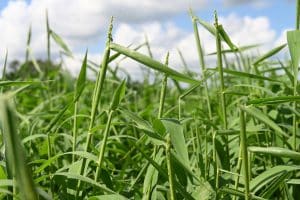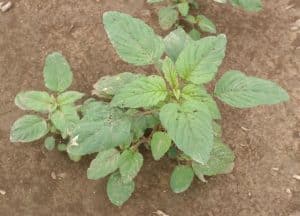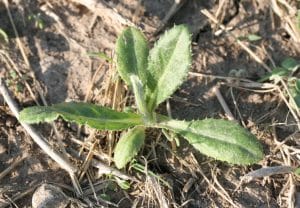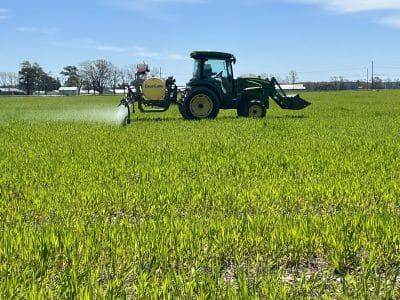Sorghum bicolor L.
Also known as black amber, cane, or chicken corn
Note: This information is based on experience in the Mid-Atlantic states; recommendations in other regions may vary.
Shattercane is an extremely competitive grass weed species that commonly reach heights of 7 to 9 feet and can form thick, dense patches in fields and roadsides. Shattercane is an annual weed that does not have rhizomes. It is very competitive with field crops.
Identifying Features
Leaves of shattercane are long and can be as wide as 3 inches. Its seed head is a loose or open panicle that tends to droop and shatters easily, spreading seeds and causing future weed problems. Shattercane seeds are large and rounded. The seed remains attached to the base of the young seedling and can be seen by carefully removing young seedlings from the soil.

Seed Production
A shattercane inflorescence (seedhead) can produce up to 1,500 seeds. If a single plant develops three heads, total production per plant can reach 4,500 seeds.
Herbicide-Resistance
Biotypes of shattercane resistant to Group 2 exist in the United States.
Management
Preventing the introduction of this species is important to its management. Since shattercane is an annual species, timely cultivation and mowing are effective strategies for control.
This species have large seeds that allow it to emerge from over 1 inch deep in the soil. Herbicide concentrations from soil depths of more than 1 to 1.5 inches are often below the levels needed to control seedlings. Therefore, control of these species with soil-applied herbicides is difficult.
Corn
Pendimethalin (Prowl) will suppress seedling shattercane, but it will need a postemergence herbicide application. Postemergence control is very good to excellent with nicosulfuron (Accent Q) or glyphosate.
Sorghum
Johnsongrass and shattercane are closely related, and there are no satisfactory broadcast treatments currently available for controlling this species in grain sorghum. Grain sorghum should not be planted in fields infested with shattercane.
Soybean
Shattercane is suppressed with pendimethalin (Prowl) or trifluralin (Treflan) if incorporated prior to planting, but they will not provide full-season control and will need to be treated with a postemergence herbicide application. Group 1 herbicides (clethodim [Select], fluazifop [Fusilade], quizalo-fop [Assure II, Targa], sethoxydim [Poast]) and glyphosate will provide excellent control of shattercane emerging from weeds.
Small Grains
This species is sensitive to frost and emerges in late spring; therefore, they are not problem weeds in small grains.
Perennial Forages
For grass hay crops, there are no selective postemergence herbicides to control shattercane. Pendimethalin (Prowl H2O) applied prior to seedling emergence will suppress shattercane. In alfalfa, Group 1 herbicides and glyphosate will provide excellent control of shattercane emerging from weeds.
Fallow or Spot Treatment
Glyphosate applied in the fall will provide an opportunity to control Johnsongrass rhizomes in fields infested with shattercane.
This content was presented in “Mid-Atlantic Field Crop Weed Management Guide” (2020), Penn State Ag Communications, AGRS-136






